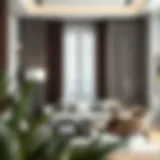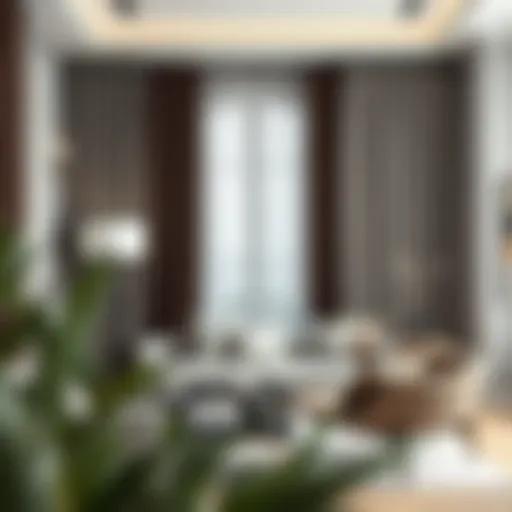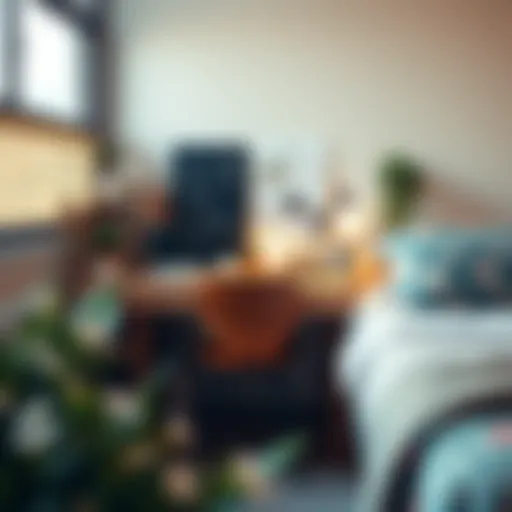Master Closet Cabinets: Optimize Space and Style
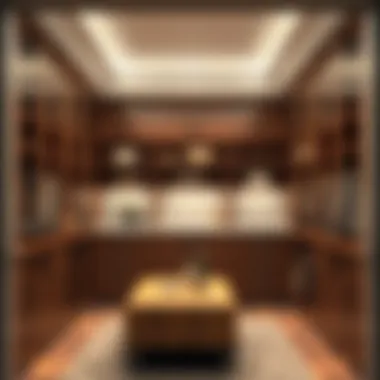

Intro
In the realm of interior design, closets often take a backseat to more public spaces like living rooms and kitchens. Yet, the master closet is a crucial element for home efficiency and aesthetics. It is not just a space for hanging clothes but can function as a personal sanctuary of organization. Understanding the significance of master closet cabinets allows homeowners, designers, and DIY enthusiasts to tap into the potential of this often-overlooked area. This comprehensive guide will uncover the myriad styles, materials, and configurations available, providing invaluable tips on how to maximize both functionality and visual appeal.
As we explore this topic, we will cover the modern trends shaping the design and visibility of master closet cabinets. Attention to detail in cabinet design speaks volumes, enhancing not only the usability of your storage space but also the overall value of your home. Whether you're a homeowner looking to optimize your closet, a designer crafting a space for a client, or a DIYer eager to tackle a project, this guide serves as a resource to elevate your approach to master closet cabinets.
Furniture Styles and Trends
Understanding the styles that dominate the market is key to making informed decisions for your closet. The right choice can transform a functional space into an inviting retreat where organization is effortless.
Modern vs. Traditional: Understanding the Aesthetics
When talking about master closet cabinets, the divide between modern and traditional styles is often a significant factor in one's design choices. Modern styles tend to embrace minimalism with clean lines, open spaces, and innovative materials like glass or metal. Think sleek cabinetry that blends seamlessly into the environment; it’s like wearing well-fitted clothes that complement your style.
On the other hand, traditional styles offer warmth and richness through classic woods and intricate designs. A cherry wood cabinet with carved accents tells a story, suggesting a sense of history and comfort. Homeowners must assess their personal preferences and the overall theme of their residence before diving into the deep end of style selection.
Color and Material Trends: What's In and What's Out
Color and material selections can set the tone in your master closet. Currently, there is a shift toward lighter colors and natural materials. Shades like soft whites, greys, and pastel hues create an airy feel, which is essential for smaller spaces. Wood finishes, especially in oak or walnut, are making a comeback.
Conversely, darker hues like navy or deep green are also finding popularity, particularly in modern designs. Matte finishes are gaining traction as they offer a touch of sophistication that gloss finishes haven’t been able to match. Avoid flooring that doesn’t align with current trends, as it might leave your closet feeling outdated.
"Embracing the right aesthetic not only enhances the closet experience but also boosts the appeal of your home."
Furniture Care and Maintenance
While choosing the right master closet cabinets is fundamental, proper care and maintenance are equally crucial in extending their lifespan and keeping them looking their best.
Tips for Prolonging the Life of Your Furniture
Keeping master closet cabinets in top shape requires a few simple yet effective practices:
- Regular Dusting: A soft microfiber cloth works wonders. Dust buildup can be a culprit in ruining finishes.
- Avoid Excess Moisture: Keep the closet as dry as possible. Humidity can warp even the best-crafted wood.
- Use Non-Toxic Cleaners: Chemicals can erode finishes faster than you can say "DIY." Gentle soaps or natural alternatives are always a safer bet.
DIY Repair Hacks for Common Furniture Issues
Occasional wear and tear are inevitable. Here are a couple of DIY hacks to tackle common issues:
- Scratches and Dents: For wooden surfaces, use a wax crayon that closely matches your cabinet’s color. Smooth it over the scratched area and buff it with a soft cloth.
- Loose Hinges: Tightening loose cabinet hinges can greatly improve function without requiring new parts.
Understanding Master Closet Cabinets
Master closet cabinets serve as an essential framework in effectively organizing and enhancing personal space, offering both style and functionality. The importance of master closet cabinets cannot be overstated, especially in today’s fast-paced world where space optimization is critical. These cabinets blend aesthetics with practicality, catering to the diverse needs of homeowners, designers, and DIY enthusiasts alike. Having a meticulously organized closet can lead to a more serene living environment, allowing you to easily find your belongings without wasting time.
Definition and Purpose
Master closet cabinets are specialized storage units designed to maximize the organization of clothing, accessories, and other personal items within a closet space. Unlike traditional storage solutions, these cabinets can be customized to fit specific dimensions and styles, ensuring a seamless integration into any home decor.
Their primary purpose is to streamline the storage process—imagine transforming a cluttered closet into a well-organized area where every piece has its place. From built-in drawers for delicate items to open shelving for easy access to shoes, each component serves a unique function. Not only do they promote efficiency in daily routines, but they also enhance the overall look of the space.
"Effective organization is an art form. When done right, it reflects both personality and purpose."
Historical Perspective
The evolution of closet design dates back centuries. Initially, clothes were merely hung on hooks or stored in wooden chests. With time, the concept of dedicated storage evolved. In the early 20th century, the emergence of built-in closets became a standard feature in homes, largely due to rising middle-class demands and more emphasis on personal space.
As home design progressed, so did the functionality of closets. By the late 70s and 80s, modular systems began to appear on the market, allowing homeowners to customize their spaces more intuitively. Modern master closet cabinets are often a culmination of these advancements—tailored solutions that balance utility and style. Today, they incorporate various materials and innovative designs, ranging from sleek minimalism to luxurious wood finishes, allowing for a variety of personal expressions in home decor.
Understanding this historical perspective not only highlights the transformation of closet spaces but also emphasizes the growing importance of designing personal spaces that cater to both functionality and aesthetics. Master closet cabinets today stand as testament to that evolution, serving not only practical functions but also acting as a stylish statement in how we store and display our belongings.
Design Variations
When it comes to master closet cabinets, understanding design variations is pivotal for homeowners looking to optimize both space and style. The choice between different designs not only alters the aesthetic appeal of the home but also dramatically impacts functionality. Each variation serves unique purposes, accommodating diverse needs and preferences. By selecting the right design, individuals can tailor their storage solutions to fit their specific lifestyles, ensuring that the master closet becomes a haven of organization rather than a chaotic jumble.
Built-in vs. Freestanding
When contemplating closet cabinet designs, one significant decision revolves around choosing between built-in and freestanding units. Built-in cabinets are designed to fit into the specific dimensions of the closet space, allowing for a seamless integration with existing architecture. This approach often maximizes every inch, making it ideal for smaller areas. The result is a polished look that can create an illusion of more room. Furthermore, built-in options can be customized to include various compartments for shoes, accessories, and clothing, catering specifically to the homeowner's habits.
On the flip side, freestanding cabinets offer a level of flexibility that can be quite appealing. They can be relocated, adapted, or removed as needs change. This is particularly advantageous for renters or those who frequently update their interior design. Additionally, freestanding units come in a variety of styles, allowing homeowners to express their unique tastes. However, it's essential to ensure that the dimensions of these units align with the available space to avoid an overcrowded feel.
Walk-in Closet Cabinets
Walk-in closets offer a luxurious touch to any home, and the cabinets chosen for these spacious areas should reflect that. These cabinets can turn a mundane storage space into a stunning wardrobe display. Walk-in closet cabinets typically allow for open shelving, long hanging areas, and thoughtful visibility, encouraging an efficient wardrobe selection process. They can also incorporate seating, mirrors, and even lighting to enhance usability and style.
Opting for elegant finishes and organizational features can transform a walk-in closet into a personal dressing room. Some homeowners may decide to use a combination of drawers and hanging racks for optimal garment care and accessibility. With proper design, essentially any shape can be accommodated—making walk-in closet cabinets ideal for both functionality and fashion.
Reach-in Closet Solutions
For homes with reach-in closets, the design needs to focus on maximizing limited space without sacrificing style. Reach-in cabinets can often be overlooked, but with the right solutions, they can be incredibly efficient. Utilizing shallow shelving and stacking options can help make the most of vertical space. These solutions allow for the storage of seasonal clothing, accessories, and more, all while maintaining an orderly look.
In recent years, some homeowners have turned to innovative solutions such as tri-fold doors and pull-out trays to enhance the functionality of reach-in cabinets. This ensures that even in a compact area, there’s room for creativity and efficient storage. Clean lines and subtle finishes can make these spaces feel more expansive, reflecting a polished aesthetic without overwhelming the room.
"The design of a space can profoundly influence how we feel and operate within it. Opt for solutions that not only serve the purpose of storage but also enhance your quality of life."
In summary, the design variations in master closet cabinets incorporate a wide range of factors that can fundamentally reshape the organization and presentation of personal belongings. Choosing between built-in or freestanding options, embracing the luxury of walk-ins, or creatively optimizing reach-in spaces, each opportunity reveals distinct pathways to enhance your home's functionality and visual appeal.
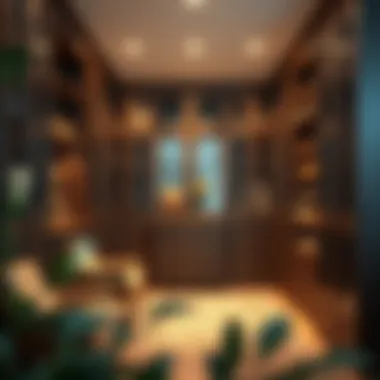

Materials and Finishes
Understanding the variety of materials and finishes available for master closet cabinets is crucial for both functionality and aesthetics. Choices in material not only affect the durability and maintenance of cabinets, but they also contribute significantly to the overall visual appeal and organization of the closet space. When designing or renovating a master closet, homeowners should consider how materials and finishes can solve practical issues while enhancing style.
Wood Options
Wood has long been a favored choice in home cabinetry due to its warmth and timeless appeal. From oak to cherry, the type of wood selected can radically influence the cabinet's style and durability.
- Versatility: Different wood grains and finishes provide a wide array of styles from rustic to modern.
- Durability: Hardwoods such as maple and oak are particularly well-known for their strength and longevity. They can withstand daily wear, promising years of use.
- Sustainability: With the rising concern for eco-friendly living, sourcing reclaimed or sustainably harvested wood can be a responsible choice. Look for certifications such as FSC (Forest Stewardship Council) to ensure environmentally conscious practices.
"Choosing the right wood can turn a simple cabinet into a statement piece that speaks to the heart of a home."
Metal and Glass Combinations
Incorporating metal and glass into closet cabinets not only elevates the design but also introduces a contemporary touch. This combination is ideal for those wanting to marry modern aesthetics with functionality.
- Elegance and Transparency: Glass doors can visually widen a space, allowing for a display of contents while keeping dust and clutter at bay.
- Maintenance: While beautiful, glass requires regular cleaning to maintain its shine. Choosing tempered glass can improve durability and safety.
- Metal Accents: Incorporating metal trims or frames can provide striking contrast and enhance the durability of glass elements. Stainless steel or brass can effectively complement wooden elements, creating a balanced design.
Eco-friendly Alternatives
As homeowners become increasingly eco-conscious, opting for eco-friendly materials in their closet designs becomes paramount.
- Bamboo: This material gains traction due to its rapid growth cycle and demand for less water compared to traditional woods. Bamboo cabinets are strong, lightweight, and naturally resistant to moisture.
- Recycled Materials: Cabinets made from recycled wood or metal are not only environmentally friendly but often lend a unique character to the overall design.
- Low-VOC Finishes: Selecting finishes that emit low volatile organic compounds (VOCs) is crucial for indoor air quality, leading to a healthier living space.
Common materials and finishes can shape the effectiveness and beauty of a master closet; understanding the nuances of each will lead to informed decisions that reflect both personal taste and practical needs.
Configuring Your Space
Configuring your space when it comes to master closet cabinets is more than just a matter of aesthetics. It's about functionality and maximizing every last inch of your closet area. A well-thought-out configuration can transform a chaotic assortment of clothes and accessories into an organized haven. It's essential to consider factors such as the layout, the availability of vertical space, accessibility, and your personal storage needs. Here’s why this aspect is critical in any decision-making process regarding your closet.
Maximizing Vertical Space
Vertical space is often overlooked in many households. It’s one of the most rewarding areas to utilize and can make a significant difference in your closet's storage capacity. By extending your cabinetry upward, you can create several additional tiers of storage without needing larger floor space. Shelves placed near the ceiling can house seasonal items, storage bins, or less frequently used outings such as luggage.
Additionally, it’s wise to invest in tall cabinetry.
- Adjustable shelving: This helps accommodate varying item heights, allowing flexibility as your storage needs grow or change.
- Vertical dividers: Great for keeping shoes organized and visible, taking full advantage of vertical arrangements.
- Hooks and racks: Integrating hooks on walls or cabinet sides can add versatility for items like scarves or belts.
Incorporating Drawers and Shelves
Drawers and shelves are core components of any closet configuration. Each serves a distinct purpose and can significantly enhance organization. Drawers, for instance, keep smaller items safe from getting lost in larger spaces. They’re particularly helpful for undergarments or accessories. The ease of access adds a layer of convenience; it's much simpler to pull out a drawer than to sift through a pile of clothes.
When it comes to shelves, they can be your best friends.
- Open shelving: Offers visibility for your belongings. You can showcase your favorite accessories without digging through a drawer.
- Deep shelves: Perfect for storing folded clothes or large handbags. A deep shelf eliminates the risk of items falling over, thus saving you from the inevitable mess.
Custom Solutions for Unconventional Spaces
Closets come in all shapes and sizes, sometimes resembling a puzzle more than a storage area. For those unique spaces that don’t fit traditional configurations, custom solutions are your go-to option. Tailoring your cabinetry allows you to harness even the most awkward spaces effectively.
A few considerations include:
- L-shaped or corner cabinets: These designs can perform magic in underused areas.
- Built-in benches: If you’ve got a little nook, a bench provides a perfect seating option and additional storage beneath it.
- Sliding doors: Ideal for tight spaces where a swinging door would intrude on your flow. They provide easy access without compromising on room.
Configuring your closet space effectively means instilling both order and accessibility. By utilizing vertical space, incorporating drawers and shelves, and crafting custom solutions, you’re not just designing a closet—you're creating a well-structured, efficient part of your home that adds to daily living.
A well-organized closet isn't just a luxury; it's a long-term solution that saves time and frustration every day.
By focusing on these configurations, you're paving the way to optimize both the space's functionality and aesthetic appeal.
Functional Features
When it comes to master closet cabinets, functional features play a vital role in enhancing both usability and efficiency. These elements are not merely add-ons but foundational aspects that can significantly influence your daily organization and storage strategy. By focusing on functional features, homeowners can tailor their closets to reflect personal needs, ultimately leading to a more streamlined lifestyle.
Accessory Storage Options
Having a variety of accessory storage options is essential for maintaining a clutter-free space. Many homeowners have an array of items that aren't strictly clothing, such as belts, ties, handbags, and scarves. Incorporating dedicated storage solutions for these accessories is often overlooked. Here are a few ways to maximize accessory storage:
- Belt and Tie Racks: These can be wall-mounted or included in drawer systems, ensuring easy access and visibility. It keeps items from tangling and makes it simpler to choose what to wear quickly.
- Tray Dividers: Using trays to separate smaller items like jewelry or watches can keep them organized and prevent damage. Consider using materials that complement the overall style of the cabinet.
- Hooks and Pegboards: These can be placed inside doors or on the sides of cabinets, freeing up shelf space while allowing for versatile storage options.
By thoughtfully considering these features, you can create a designated space for accessories, elevating the functionality of your closet significantly.
Lighting Solutions
Another important aspect is the inclusion of effective lighting solutions. The right lighting can transform even the most cramped closet into a bright, inviting space. When choosing lighting, consider the following:
- LED Strip Lights: These are great for along shelves or inside drawers, providing visibility while being energy-efficient. They can be placed in a way that highlights key items, making it easier to find what you need at a glance.
- Motion Sensors: Installing motion sensor lights ensures that you have illumination right when you step into the closet. This feature is particularly useful for deeper walk-in closets where you might not want to fumble for a switch in the dark.
- Ambient Lighting: Using overhead fixtures can set a pleasant tone, while integrated puck lighting in shelves can emphasis your clothing or decorative elements.
With well-planned lighting, your closet becomes not just functional but also a more pleasant environment.
Built-in Technology Integrations
Built-in technology integrations are becoming increasingly essential for those who desire seamless functionality in their master closet cabinetry. As smart home technology evolves, so too does its application in this personal space. Here are notable tech features to consider:
- Smart Mirrors: Some mirrors can display time, weather, or even act as screens to help you while you get ready. They might even have built-in lighting that adjusts based on the time of day.
- Automated Shelves or Drawers: These can be configured to slide in or out at the push of a button, an excellent feature for deeper storage areas that are hard to reach.
- Inventory Management Systems: Some modern closet systems come equipped with apps that help you track what you own, notifying you of what’s missing or what hasn’t been worn in a while.


By embracing technology, you can elevate the utility and convenience of your closet, making it not just a place for storage, but an integral part of your daily routine.
"A well-organized closet with functional features not only saves time but also enhances your overall lifestyle, making it worth the investment."
In essence, prioritizing functional features within your master closet cabinets enriches your living experience. From accessory storage options to thoughtful lighting solutions and technological advancements, these elements put function first, making your daily routines a lot smoother.
Aesthetic Considerations
When dealing with master closet cabinets, aesthetics isn't just about looks; it's about creating a harmonious space that feels inviting and reflects the homeowner's personal style. A closet can transform from a mere storage area into a stylish enclave when the right aesthetic choices are made. This section explores the pivotal elements of aesthetic considerations such as color schemes, decorative elements, and how to coordinate cabinets with existing interior design themes.
Color Schemes and Finishes
Color can set the entire mood of a closet. Soft hues like pastels or neutrals tend to make spaces look larger and more airy, while darker shades can bring depth and sophistication. Choosing the right finish—be it matte, glossy, or textured—can also change how light interacts with the space. For instance, a high-gloss white finish might increase brightness, making the area feel more open, whereas a darker stain on wood can introduce warmth and an element of richness.
When planning your color scheme, consider:
- Personal Preference: Colors speak volumes about personality. If cobalt blue gets you up in the morning, use it!
- Existing Decor: Is there a dominant color in the bedroom? Extending that theme into the closet can unify the overall design.
- Natural Light: Consider how much light enters the space; this can affect how colors look throughout the day.
Decorative Elements
Decorative elements play vital roles in enhancing the aesthetic appeal of master closet cabinets. Think about incorporating things like:
- Hardware: The knobs and pulls you choose can dramatically impact the overall look. Sleek chrome for a contemporary feel, or antique brass for a vintage touch.
- Lighting Fixtures: Pendant lights or sleek sconces can add drama and also serve practical purposes, like increasing visibility in shaded corners.
- Personal Touches: Items like framed photos, stylish storage boxes, or even a mini sculpture can personalize the space and give it character.
"A closet should be a reflection of you, not just a repurposed room for clothes."
Coordinating with Interior Design Themes
When integrating master closet cabinets into the home's broader design scheme, synergy is key. Each element should complement others in the space rather than clash with them.
Here are tips to ensure coordination:
- Match Styles: If the rest of your home features modern minimalism, avoid ornate cabinetry that would feel out of place. Clean lines and understated elegance will work best.
- Textures: If your bedroom is plush with textiles, incorporating soft, inviting textures in the closet can maintain that feeling while enhancing visual interest.
- Consistent Color Palette: Applying a consistent color palette across different areas of the house can create a sense of cohesion, making your entire living space feel more curated.
In essence, a thoughtful approach to aesthetics in master closet cabinets not only improves functionality but also enriches the overall ambiance of your home. It turns a utilitarian space into a delightful area that enhances your daily routine, while speaking to your unique sense of style.
Economic Considerations
When homeowners embark on the journey of upgrading their master closet cabinets, economic considerations become paramount. Delving into the financial aspects not only influences the type of materials and finishes chosen but also shapes the overall project scope. Investing wisely in closet cabinets can yield dividends in both functionality and style.
The significance of economic factors hinges on various specifics. Budget constraints dictate decisions about custom solutions versus stock options. Additionally, understanding the long-term value these installations can bring aids in making informed choices that balance cost with potential returns on investment.
Budgeting for Custom Solutions
Creating a beautiful and functional master closet cabinet may appear daunting, especially when it comes to budgeting for custom solutions. One of the first steps lies in setting a realistic budget that encompasses more than just the cabinets themselves. Homeowners must consider design consultations, installation costs, and any additional features such as specialized lighting or integrated technology.
When calculating your budget, it’s wise to factor in these elements:
- Materials: Decide whether you're leaning towards premium hardwoods or more economical options. Costs can vary dramatically.
- Labor: If you’re hiring professionals, get detailed quotes that encompass all potential costs. Sometimes the cheapest quote isn’t the best in the long run.
- Customization Features: Think about how customizations—like adjustable shelving or pull-out drawers—impact the total cost. Some features may seem appealing but can add up quickly in expenditure.
Creating a budget breakdown not only helps in tracking expenses but achieving a clearer vision for the project.
Cost vs. Value Analysis
Evaluating the cost in relation to the value gained from your closet cabinets is essential. A well-executed investment can appreciably enhance the functionality of a master closet while also elevating the overall appeal of a home.
Conducting a cost versus value analysis requires a straightforward approach:
- Assess the Features: Consider what functionality is necessary versus what would be a luxury. Clearly, a feature that significantly improves usability justifies its price.
- Market Trends: Research similar homes in the area to understand what upgrades contribute to property value enhancement. Often, well-implemented closet systems attract buyers and can yield higher resale prices.
- Slice of Life: Think about daily activities. A well-organized closet isn’t just a vanity project; it saves time and reduces stress.
"Investing in master closet cabinets is not just a home improvement; it’s a step towards an organized lifestyle and can translate into a solid financial return when it's time to sell."
Performing a thoughtful cost versus value analysis allows you to gauge whether the expected benefits outweigh the expenses involved in the installation of custom cabinets. By prioritizing efficiency and aesthetics within your economic framework, you set the stage for a master closet that genuinely complements your lifestyle.
Installation Process
The installation process is a crucial component of implementing master closet cabinets effectively. It’s not just about placing cabinets in a space; it’s about ensuring they are functional, stylish, and built to last. Proper installation can significantly impact the usability of the space. When cabinets are installed correctly, homeowners experience better organization, reduced clutter, and an aesthetically pleasing result.
Proper attention must be paid to how each piece interacts with the overall space. Assessing the layout and how the doors function is paramount. For instance, cabinets that block other storage elements or disrupt traffic flow can lead to frustration. Likewise, the choice between DIY installation or hiring a professional can shape the outcome. Evaluating the pros and cons of each approach guides homeowners in making informed decisions that cater to their skills, budget, and time constraints.
"The right installation can turn an ordinary closet into an extraordinary storage solution."
DIY Installation Tips
For those inclined to tackle the installation process themselves, there are several tips that can prove invaluable:
- Measure Accurately: Before making any cuts or purchases, measure the closet space meticulously. Even a slight miscalculation can lead to wasted materials or unfit cabinets.
- Gather the Right Tools: Essential tools include a drill, level, measuring tape, and screwdriver. Investing in quality tools makes a noticeable difference.
- Plan Your Layout: Sketch out a plan of how cabinets will fit within the space, considering factors such as clearance and ease of access. This visual roadmap can streamline the assembly process.
- Follow Manufacturer Instructions: Each cabinet system might have unique requirements. Adhering strictly to these guidelines helps avoid common installation errors.
- Use Wall Anchors: Especially for taller units, wall anchors are critical. They provide enhanced stability and prevent tipping.
- Don’t Rush: Take your time. Double-check each step to ensure everything is aligned and secure before moving on to the next phase.
For more hands-on advice, check out discussion boards like Reddit and forums where experienced DIYers share their tips and lessons learned.
Hiring Professionals
While taking a hands-on approach can be satisfying, sometimes hiring a professional is the best bet. Here are a few considerations to keep in mind:
- Experience Counts: Professionals typically have extensive experience and can handle unexpected complications that may arise during installation. Their expertise in working with various materials and designs ensures a better finish.
- Time-Saving: Professionals will likely complete the installation much quicker than a DIY enthusiast. This can be especially beneficial for homeowners short on time or who need to move in quickly.
- Quality Assurance: Professionals ensure a level of polish and precision that might be hard to achieve without proper training and tools. If the final appearance is important, investing in a professional installer could be your best option.
- Liability and Warranty: Many professionals offer warranties on their work, giving peace of mind that any issues can be handled efficiently.
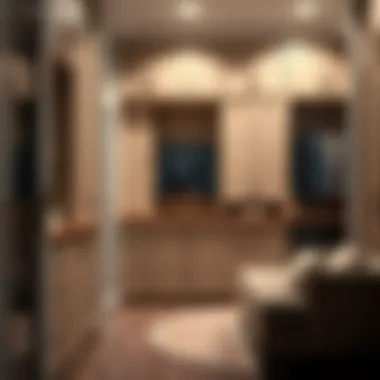

For reputable installation services, websites like Angie's List can connect you with qualified professionals in your area.
Maintenance and Care
Taking care of your master closet cabinets is not just about keeping them looking nice; it’s a crucial step in ensuring they function optimally over time. The right maintenance routine preserves finishes, keeps your organizational tools in top shape, and can extend the life of the cabinets. Homeowners, designers, and DIY enthusiasts alike can benefit from understanding these practices.
The first thing to consider is that various materials have different needs. For instance, while a wood cabinet might require occasional polishing, a metal one could just need a gentle wipe. Furthermore, regular inspection and cleaning can prevent dust buildup, which can lead to blemishes and functional issues down the road. Protecting your investment is key.
Cleaning Recommendations
Keeping your master closet cabinets clean goes a long way in maintaining their aesthetic appeal and functionality. Here are some recommendations:
- Dust Softly: Use a microfiber cloth to avoid scratching surfaces. It traps dust particles without creating friction.
- Avoid Harsh Chemicals: Cleaning solutions with bleach or strong solvents can damage finishing. Opt for mild soap and water for most materials.
- Spot Test: If using a new cleaning product, always test it in a less-visible area first. This precaution can help avoid unsightly stains or reactions.
- Regular Schedule: Establish a routine—consider cleaning once a month, or more frequently if you live in a high-traffic area where dust and dirt accumulate fast.
Keeping the interiors of cabinets tidy is just as necessary. Empty out shelves every so often, giving them a thorough clean along with reorganizing items as needed.
Protecting Finishes
A little effort can go a long way when it comes to protecting the finishes on your cabinets. Damaging elements like sunlight, heat, and moisture can wear down even the most durable finishes:
- Strategic Placement: Make sure to avoid placing cabinets near extreme heat sources or direct sunlight, which can fade colors and warp materials over time.
- Use Liners: Consider using shelf liners made from breathable materials. They can protect the surface from stains and make cleaning simpler.
- Avoid Heavy Items: Do not overload shelves with heavy objects. Excess weight can cause sagging and may lead to scratches or markings on the surface.
- Touch-ups: Keep a small can of touch-up paint or varnish on hand for minor scratches or chips. Addressing these quickly can prevent further damage.
"The longevity of your cabinets is a direct reflection of how well you treat them. A consistent maintenance routine pays off when you see them standing tall and looking great for years."
By adhering to these cleaning and protection strategies, you can ensure that your master closet cabinets remain not only functional but also a stylish part of your home's design. Incorporating these habits into your routine can transform your closet experience, making it as enjoyable as it is practical.
Trends in Master Closet Design
In the ever-evolving world of home design, master closet cabinets are far from being mere storage spaces. They have transformed into essential components that reflect both personal style and practicality. Understanding the current trends in master closet design is crucial for homeowners, designers, and retailers alike, as these trends not only influence aesthetic choices but also enhance functionality.
Adopting modern trends can significantly elevate both the look and efficiency of a space. This section will dive into two prominent trends shaping the future of master closet cabinets: Smart Closet Solutions and Sustainable Design Practices.
Smart Closet Solutions
Smart closet solutions are leading the way in making organization easier and more intuitive. These innovations seamlessly integrate technology into the design, offering features that streamline personal routine while adding convenience to daily life. Some specific benefits of incorporating smart technology include:
- Automated Lighting: Think of motion-sensor lights that switch on as you step into your closet, eliminating the need to fumble for switches. This not only enhances visibility but also saves energy.
- Integrated Audio Systems: Enjoy your favorite tunes or podcasts during your morning routine with built-in Bluetooth speakers. It can turn an ordinary space into a personal concert.
- Virtual Organizing Tools: Mobile applications that connect with closet systems can help manage wardrobe inventories. Users can keep track of what’s in their closet, mix and match outfits, or even plan for upcoming events.
"The integration of technology in home design is no longer optional; it's about making life simpler and more efficient."
These features cater to the tech-savvy individuals looking to optimize their space while also appealing to those who simply want ease in everyday chores. The idea here isn't just about filling up space with cabinets; it’s about creating a cohesive environment that supports a seamless lifestyle.
Sustainable Design Practices
As society leans more towards environmentally conscious living, sustainable design practices also emerge as a significant trend in master closet design. Homeowners are now evaluating how their choices impact the planet, leading to a shift in the materials and methods used in closet construction. Here are some key considerations:
- Recycled Materials: Utilizing recycled wood and metal can minimize the carbon footprint associated with new materials. This approach not only preserves natural resources but also offers unique aesthetic possibilities.
- Energy-efficient Lighting: The use of LED fixtures not only saves energy but also comes in various styles and temperatures, enabling a customizable light atmosphere.
- Low-VOC Finishes: Opting for paints and finishes with low volatile organic compounds (VOCs) contributes to better air quality inside the home. eco-friendly choices ensure that craftsmanship doesn’t compromise health.
Incorporating these practices signals a commitment to sustainability. Not only does it cater to environmentally conscious consumers, but it also aligns well with contemporary design philosophies that celebrate clean, smart living.
By embracing technology like smart closet solutions and committing to sustainability, homeowners can create master closet spaces that are both stylish and functional. This synergy of form and function sets the standard for modern designs, where style meets responsible living.
Impact on Home Value
Master closet cabinets play a significant role in the overall value of a home. As more homeowners prioritize organization and efficient use of space, these cabinets become critical assets in enhancing a property's appeal. When prospective buyers walk through a home, the presence and condition of master closet cabinets can create a lasting impression.
Appraisal Insights
When an appraiser evaluates a home, many factors come into play, and closet space is often part of that equation. Upgraded master closet cabinets can lead to a favorable appraisal outcome. For instance, custom installations, quality materials, and overall organization visibly contribute to increased marketability and perceived value. If an appraiser comes across a well-organized closet boasting aesthetically pleasing cabinets, it could result in a higher valuation than a space lacking these features.
Some key elements that appraisers often consider include:
- Quality of Materials: High-quality woods, metals, and sustainable finishes add to the visual appeal.
- Size and Layout: A spacious, well-planned design that maximizes storage options will be more valuable.
- Functional Features: Accessories such as built-in lights, drawers, and additional storage solutions can boost a closet's usability and thereby its worth.
Market Trends
In today's real estate landscape, homebuyers express a strong interest in functional spaces that reflect modern living. Trends indicate that buyers are increasingly seeking homes with well-designed storage solutions. Master closet cabinets that are tailored to fit individual lifestyles often sway purchasing decisions.
Current market insights reveal a few notable shifts:
- Smart Closets: Technology integration such as smart shelving or automated lighting systems captivates tech-savvy buyers.
- Minimalist Aesthetic: There’s a rising trend for clean lines and simple finishes that create a serene environment. A clutter-free closet design appeals to millennials and younger generations, driving interest.
- Sustainable Options: Eco-friendly materials resonate with environmentally conscious buyers. From bamboo finishes to reclaimed wood, these choices not only enhance style but also speak to changing values in home design.
A well-thought-out master closet is no longer just an organizational space; it’s a crucial selling point, making it essential for homeowners to focus on quality and design when installing cabinets. In turn, this can enhance both day-to-day enjoyment and long-term financial returns.
Case Studies and Examples
Examining case studies and real-life examples sheds light on how master closet cabinets function in various settings. By unpacking success stories, we can illustrate practical applications and inspire creativity in design. Moreover, learning from mistakes made by others adds a layer of wisdom to the decision-making process.
Successful Implementation Stories
Master closet cabinets serve as an essential element in creating a functional and visually appealing space. For instance, consider a recent renovation in a suburban home where the homeowner struggled to keep their wardrobe organized. They decided to install custom cabinets tailored to their specific needs. After a thorough review of their clothing collection and lifestyle, they chose a combination of drawers for folded items, hanging space for longer garments, and shelving for accessories.
This particular implementation yielded a 40% increase in usable space while transforming the aesthetic appeal of the room. The choice of warm wood finishes, combined with soft LED lighting, not only enhanced visibility but also contributed to a cozy yet sophisticated atmosphere.
Another inspiring case comes from a city apartment where maximizing limited space was crucial. The homeowner opted for a reach-in closet solution with mirrored doors that doubled as full-length mirrors. This added functionality without compromising style. Through clever installation of vertical shelving, the homeowner could store shoes and bags neatly, leading to less clutter and quicker access to daily necessities.
Mistakes to Avoid
When diving into the world of master closet cabinets, several common pitfall can derail the project.
- Underestimating Storage Needs: It’s vital to evaluate your closet space realistically. Many homeowners opt for designs that don’t consider future needs, leading to overcrowded drawers and overflowing shelves.
- Ignoring Layout Versatility: Choosing a static or rigid layout can be limiting. Flexibility is key. For example, using adjustable shelves helps accommodate varying heights of items and allows for changes over time.
- Neglecting Aesthetics: Function shouldn't come at the expense of visual appeal. Remember to think about colors and styles that align with the broader interior theme of the home. An aesthetic mismatch can detract from the overall design.
- Skipping Professional Input: Certain designs may appear simplistic but involve complexities in execution. Hiring professionals or consulting with designers ensures that recommendations match the latest trends and safety standards.
- Failing to Plan for Lighting: Adequate lighting is often an afterthought. Proper illumination makes a world of difference in usability—specifically for those early mornings when getting dressed feels like navigating a minefield!
